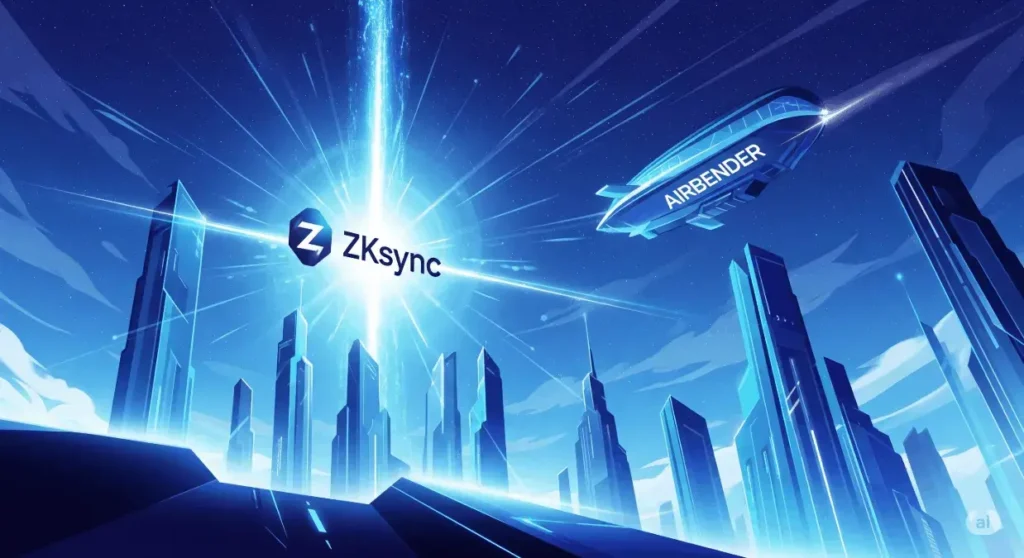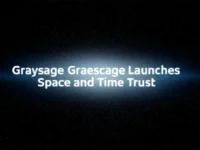Airbender: Revolutionizing Blockchain with Unprecedented ZK Proof Speed

The blockchain landscape is constantly evolving, driven by the relentless pursuit of scalability, efficiency, and true decentralization. At the forefront of this evolution stands ZKsync, captivating the industry’s attention with its latest groundbreaking innovation: Airbender. Unveiled as a high-performance zero-knowledge prover developed on a RISC-V zkVM, Airbender doesn’t just push boundaries; it shatters existing benchmarks, laying a robust foundation for truly decentralized, real-time blockchain applications that defy the traditional need for massive, energy-intensive GPU farms. This marks a pivotal moment, promising to reshape how we interact with decentralized technologies, from instantaneous micropayments to high-frequency trading and dynamic real-time decentralized applications.
Unveiling the World’s Fastest Open-Source Prover
Airbender is far more than a mere addition to the growing list of zkVMs; it stands as the fastest open-source RISC-V proving system documented to date. Its performance is a testament to cutting-edge engineering, demonstrating capabilities that significantly outpace its predecessors and rivals. In rigorous, head-to-head tests against leading competitors such as SP1 Turbo and RiscZero, Airbender showcased astonishing speed. It consistently clocked sub-second proofs for ZKsync blocks, a feat that alone underscores its efficiency. More impressively, it delivered full proofs in just three seconds on a single, readily available commodity GPU.
When deployed on high-performance NVIDIA H100 hardware, Airbender achieved a blistering 21.8 million cycles per second at the base layer. This translates into the raw computational power required for the most demanding proof generation tasks. For end-to-end proving, which includes all recursive steps necessary for finality, it maintained an impressive 8.5 million cycles per second. These figures are not just incremental improvements; they represent a dramatic 4–6 times speed boost over rival systems, solidifying Airbender’s position as a game-changer in the world of zero-knowledge cryptography. This raw speed means that complex computations, previously bottlenecked by slow proof generation, can now be processed with unprecedented velocity, enabling new paradigms for blockchain interaction and utility.
Redefining Efficiency and Accessibility: The Single GPU Revolution
Beyond the impressive raw speed, Airbender achieves breakthrough efficiency, particularly when proving Ethereum blocks. This is where its impact on the broader blockchain ecosystem becomes profoundly evident. Utilizing just one H100 GPU, Airbender wrapped up average Ethereum block proofs in under 35 seconds. Furthermore, in lean configuration tests—optimized for minimal recursive steps—it proved blocks in a jaw-dropping 17 seconds. To truly grasp the magnitude of this achievement, consider the current industry standard: existing setups typically require anywhere from 50 to 160 GPUs to achieve comparable results, albeit sometimes slightly faster at 12 seconds, depending on block size. The ability of Airbender to match this performance with a mere fraction of the hardware is a monumental leap forward in cost-efficiency and energy consumption.
These performance gains translate directly into tangible economic benefits. The dramatic reduction in hardware requirements and processing time slashes proof costs to an astonishingly low figure—around $0.0001 per transfer. This cost reduction is not just a statistical improvement; it’s a catalyst for entirely new use cases previously deemed economically unfeasible on blockchain. Micropayments, where transaction fees often outweigh the payment itself, become viable. High-frequency trading (HFT) on decentralized exchanges, demanding rapid settlement and low latency, is now within reach. Furthermore, the dream of real-time decentralized applications (dApps)—interactive platforms that respond with the immediacy users expect from traditional web services—is unlocked. Airbender thus paves the way for a more accessible, efficient, and responsive decentralized internet, removing significant economic barriers to mass adoption.
The Technological Backbone: RISC-V zkVM and DEEP STARK/FRI Architecture
The core of Airbender’s revolutionary performance lies in its sophisticated technical architecture, a synergy of cutting-edge cryptographic principles and optimized hardware integration. Built for consumer hardware, Airbender is powered by ZKsync OS’s modular zkVM. This modular approach provides developers with unparalleled flexibility, allowing them to tailor execution environments to specific needs, whether for Ethereum Virtual Machine (EVM), EraVM, or WebAssembly (WASM) compatibility. The choice of a RISC-V instruction set architecture is particularly strategic. RISC-V is an open-source, streamlined alternative to more complex instruction sets like EVM, designed for efficiency and modularity. This alignment makes it inherently better suited for the generation and verification of zero-knowledge proofs, as it simplifies the underlying computation, accelerating proof generation and execution while potentially reducing gas fees. Ethereum co-founder Vitalik Buterin has even proposed replacing the EVM with RISC-V to enhance Ethereum’s efficiency and scalability, highlighting the foresight in ZKsync’s architectural decisions for Airbender.
Airbender’s core proving engine is based on Arbitrary Instruction Set (AIR) constraints, compiled into highly optimized DEEP STARK proofs over a Mersenne31 prime field. STARKs (Scalable, Transparent ARguments of Knowledge) are a type of zero-knowledge proof known for their scalability and transparency, meaning they don’t require a trusted setup. The DEEP STARK/FRI architecture is a critical component here. FRI (Fast Reed-Solomon Interactive Oracle Proofs of Proximity) is a polynomial commitment scheme that is fundamental to the efficiency of STARKs. The DEEP variant further optimizes this by “deepening” the checks, allowing for smaller proof sizes and faster verification.
Airbender’s proving pipeline is a five-stage structure meticulously optimized for both flexibility and throughput:
- Witness Commitment: This initial stage computes low-degree extensions (LDEs) and trace commitments, preparing the data for proof generation.
- Lookup & Memory Argument: This stage validates memory operations by efficiently utilizing lookup tables, ensuring data integrity within the computation.
- STARK Quotient Polynomial: Here, circuit constraints are encoded via AIR polynomials, translating the computation into a form suitable for cryptographic proving.
- DEEP Polynomial Construction: This stage implements FRI batching, a crucial technique that significantly reduces the final proof size without compromising security.
- FRI IOPP (Interactive Oracle Proofs of Proximity): This is the final stage where the proximity proof is generated, confirming the validity of the computation with zero knowledge.
Furthermore, Airbender supports custom machine configurations, precompiled circuits for common cryptographic operations (like Blake2s/Blake3 and big-integer arithmetic), and various recursive proving modes. Its hybrid CPU/GPU design leverages the strengths of both: the CPU handles RISC-V simulation and tracing, while the GPU takes on the computationally intensive witness generation and subsequent proving steps. The implementation of all 32-bit registers in RAM simplifies the circuit design and defers register management to memory lookups, further enhancing efficiency. The use of Mersenne31 field arithmetic is optimized for STARK performance, and custom precompiles enable efficient cryptographic and big integer math through a CSRRW-opcode-based delegation mechanism. This comprehensive and innovative design makes Airbender a robust and highly performant prover.
Expanding the Airbender Ecosystem
Airbender’s impact extends far beyond its individual performance metrics; it is poised to become the foundational proving system for an expanding network of ZKsync Chains. All new ZKsync Chains, including prominent projects like Abstract, Sophon, GRVT, Lens, and Memento, are set to adopt Airbender. This widespread adoption means these chains will immediately benefit from the unprecedented savings and speed boosts offered by the new prover, enhancing their user experience and operational efficiency from the outset.
The open-source RISC-V foundation of Airbender is particularly significant. It fosters an environment of innovation, encouraging developers and innovators to explore applications far beyond the immediate ZKsync ecosystem. Imagine gaming platforms where in-game actions are instantly verified, identity solutions providing unforgeable digital credentials with privacy, and decentralized AI networks performing complex computations with verifiable integrity and low latency. Airbender enables such possibilities, providing a reliable and low-latency proving mechanism crucial for these advanced blockchain use cases. This commitment to open-source development democratizes access to high-performance zero-knowledge technology, inviting a broader community to build and innovate.
Future Outlook and Continuous Optimization
While Airbender currently remains in a beta phase, its early performance and architectural design signal a transformative future for zero-knowledge proofs. Developers are actively testing its flexible proving pipeline, exploring its five finely tuned stages from witness commitment to FRI proof generation. This iterative development process, coupled with the open-source nature of the project, means that continuous optimizations are not just anticipated but are an inherent part of Airbender’s trajectory.
The team behind Airbender is committed to further enhancements, which will likely involve refining the cryptographic primitives, optimizing the hardware-software interface, and exploring even more efficient recursive proof compositions. These ongoing efforts are poised to further reduce proof times and costs, making ZK-proofs even more accessible and pervasive. Airbender is not merely an incremental upgrade; it represents a fundamental shift in how blockchains can achieve scalability, security, and decentralization simultaneously. It is poised to reshape how computations are proven and settled in the age of zero knowledge, making real-time, mass-scale decentralized applications a tangible reality. The vision of a decentralized network of chains that coordinate, settle, and interoperate in real-time, all powered by efficient and affordable zero-knowledge proofs, is now closer than ever, thanks to Airbender.
Stay tuned for daily cryptocurrency news!
Conclusion
In conclusion, Airbender stands as a monumental achievement in the realm of zero-knowledge cryptography and blockchain technology. By delivering the fastest open-source RISC-V zk proofs, it dramatically cuts down verification times and proof costs, effectively removing significant barriers to entry for a multitude of decentralized applications. From enabling seamless micropayments and high-frequency trading to fostering real-time dApps and empowering home-proving on consumer-grade hardware, Airbender is not just an advancement; it is a paradigm shift. Its integration with ZKsync OS and its adoption across new ZKsync chains signify a future where scalability, efficiency, and true decentralization are not just aspirations but fundamental realities. The era of high-performance, accessible zero-knowledge proofs has arrived, and Airbender is leading the charge.





